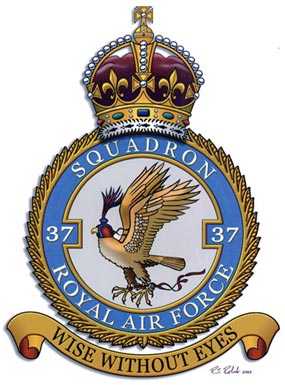"Wimpys" in the Mediterranean
While not especially well known to the general public, for most aviation historians the Vickers-Armstrong Wellington bomber (known as the "Wimpy" to those who flew them) is no stranger. 11,461 Wellingtons were built, far outnumbering any other British bomber aircraft. Most books and articles cover the role that the Wellington played as "the backbone of Bomber Command" until it was replaced in the UK front line Bomber Command squadrons by the true heavies - the Avro Manchester/Lancaster, the Handley Page Halifax and the Short Stirling. The Wellington also played a significant role as a crew trainer at numerous OTU’s - many bomber crews first flew together as a unit on Wellingtons. The role of the Wellington as a Coastal Command anti-submarine aircraft is also well documented. Perhaps only the deHavilland Mosquito and the Ju 88 could lay claim to doing as many jobs as the Wimpy. It was also used as a mine-exploder (DWI), night torpedo bomber, parachute trainer, and mine layer - there seemed to be nothing that the Wellington could not try... It did have a hard time towing gliders, because of the "give" in its unique "geodetic" construction. It served with the RAF until 1953 - a remarkable achievement given that it first flew in 1936.
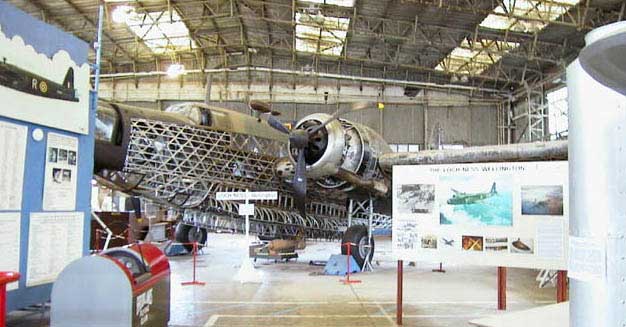
A Wellngton bomber, pulled from Loch Ness,
undergoing restoration. The bomber has yet to be "skinned",
revealing the unique
"geodetic" airframe the aircraft was famous for.
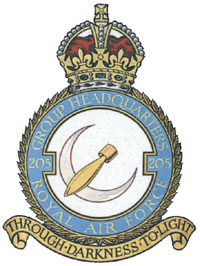 By 1944 the Wellington was
becoming obsolescent as a medium/heavy night bomber, however, the Wellington did
not disappear from front line service when it left Bomber Command Main Force in
1943. In both the Far East and in the Mediterranean Theater of Operations (MTO)
the Wellington soldiered on as the strategic bomber of choice.
By 1944 the Wellington was
becoming obsolescent as a medium/heavy night bomber, however, the Wellington did
not disappear from front line service when it left Bomber Command Main Force in
1943. In both the Far East and in the Mediterranean Theater of Operations (MTO)
the Wellington soldiered on as the strategic bomber of choice.
Wellingtons had been serving in the Middle East with 202 and 205 Groups since 1940 and had been heavily involved in the breaking of Rommel’s supply lines by bombing his supply ports at Tripoli, Bengahsi and Bizerte. Two main Wellington formations existed.
205 Group, flying Wellingtons Marks 1c, II, and III, fought from bases in Egypt at Kabrit and Shallufa - moving forward with the advancing troops to forward landing grounds and pounding the Afrika Korps by Night. Number 37, 40, 70, and 104 Squadrons flew the night strategic heavy bomber missions, while 38 and 221 Squadrons flew the Coastal Command Wimpys armed with mines, ASV radar and depth charges. Other Wimpys known as "Fishingtons" flew the night torpedo bomber role carrying two regular naval torpedoes stacked one on top of the other in the bomb bay. The idea was to catch enemy shipping in the "moonpath" and make low level torpedo attacks, dropping both "fish" in a spread. DWI Wellingtons (converted Mark I’s fitted with a gigantic degaussing ring) exploded mines in the approaches to the Suez Canal to ensure the safe use of this vital waterway. The night bombers were also called for close support of advancing troops.
|
|
Meanwhile in North West Africa, two squadrons of Wellington III’s were sent out from the U.K. to support the advances of the British and American forces after "Operation Torch". Based at Blida in Algeria and later briefly at Fontaine Chaude, these aircraft made up 330 Wing of the British North African Airforce. Jimmy Doolittle USAAF, of "30 seconds over Tokyo" fame, was in command of the Allied air forces and often flew with the Wellingtons to learn night bomber tactics. 330 Wing was made up of two Squadrons: 150 and 142, known as "Cuty" and "Jane" (a play on their fuselage squadron markings - JN for 150 and QT for 142). 330 Wing devastated the ports of Bizerte and other highly important assets of the Afrika Korps.
As Rommel was pushed out of Africa through Tunisia, the Wellingtons congregated at Kairouan in Tunisia in May/June 1943 to support the continued harrying of the retreating Africa Korps and to provide the night strategic bombing element to soften up Sicily and Italy for invasion. 330 Wing joined with 205 Group adding two squadrons. The RCAF provided three squadrons of Wellingtons from the U.K. for a period of 6 Months to assist with the preparation for the invasions - Nos. 420, 425 and 426 Squadrons. These squadrons returned to the UK in October 1943 to resume "ops" as Lancaster and Halifax Squadrons with 6 Group RCAF. By this time, most of the squadrons were equipped with the ultimate development of the Wellington - the Mark X.
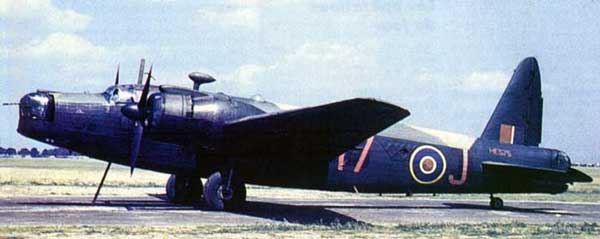
The Wellington Mark X
Constructed of new light alloys and being equipped with Bristol Hercules sleeve valve radials in place of the older Pegasus engines, the Mark X now had a far superior single engined performance. Compared to the B-17's and B-24's that they shared bases with, the Wellington Mk. X was still considered quite obsolescent, but consider this: a Wellington flying at night with a crew of five (bomb aimer, pilot, wireless operator, navigator and air gunner) could carry the equivalent bomb load (4000 lbs.) of a fully loaded Fortress or Liberator loaded with heavy ammunition and gunners for a day raid. At this time 205 Group was reinforced by units of the South African Air Force (31 and 33 Squadrons) flying B-24's and 178 Squadron RAF on Halifax II’s flying as a Pathfinder Force.
After the troops of the 8th Army had liberated the airfields on the Foggia Plain the Wellingtons of 205 Group moved in. New fields were bulldozed out of the olive groves at Cerignola, Amendola, Totorella and other bases. PSP (Perforated Steel Plate) hardstandings and runways were laid by U.S. and British Airfield Construction Battalions and "ops" started in Jan 1944. The weather was dismal, navigation aids were non-existent (no Oboe, no H2S, no radio beams). Initially crews navigated by much the same means as Columbus had - Dead Reckoning, Map reading, Astro Shots etc - and yet the reputation of 205 Group for "spot on" delivery became legend. Weather, icing and navigation were the main enemy, along with flak and night fighters. A favorite target of 205 Group was the Ploesti Oil fields in Romania. Ploesti was the third heaviest defended enemy target zone in Europe after Berlin and the Ruhr, and loses over this target proved that in a very direct way.
Throughout the late winter, spring and summer of 1944, 205 Group flew as part of the 15th U.S. Airforce - the only RAF formation ever to fly under the operational control of another country. Targets were mainly transport (docks, marshalling yards and bridges) and oil (refineries, oil ports, and storage tanks). Ranging into Northern Italy the Wellingtons hit targets such as the Varese Macchi aircraft plant, the Aircraft plant at Maribor, marshalling yards at Milan and Verona, port facilities at Trieste and Genoa and oil targets in Sophia Bulgaria, Rumania and Yugoslavia. Into Hungary they hammered marshalling yards and arms factories in Budapest. They attacked aerodromes whose day fighters were causing difficulty for the daylight raiders of the USAAF. They even flew over the Alps to attack Munich. Not bad for a "cloth bomber" named "Wimpy".
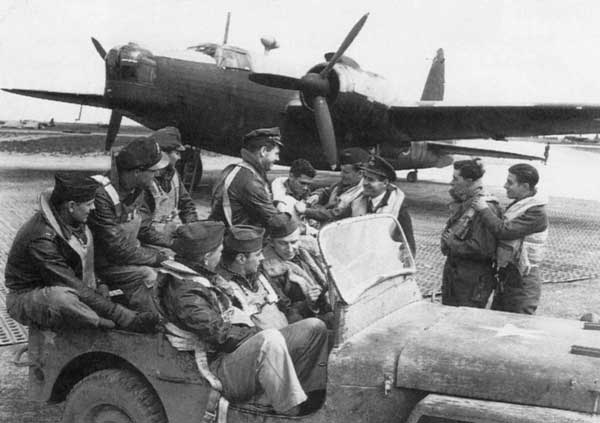
RAF Wellington Mk. X aircrew wish an American B-17 crew good luck as
they set out to raid a
Balkan target from their shared airfield on the Foggia
plain.
Perhaps the most effective attacks of 205 Group in terms of slowing the flow of oil to Germany as a preliminary to the D-Day landings was the mining of the Danube. As the rail links to the Reich were pounded by both day and night raids, the Germans turned to using river barges in the Danube to ship tons of Rumanian crude oil to the Reich. Flying at night at heights from 50 to 150 feet above the black waters of the Danube Wellingtons dropped two 1500 lb. Naval mines into the river and shot up a variety of naval craft. Both Albert Speer and Adolph Galland credit this with slowing the flow of Rumanian crude to a trickle. Indeed, some historians have postulated that lack of Rumanian crude in June 1944 stopped Hitler from moving Panzers into Normandy to push the D-Day beach head back into the ocean. Air Chief Marshall Tedder who had convinced "Bomber" Harris to allow the heavies of Bomber Command to be used to attack rail targets behind the lines as a prelude to invasion, had leaned this lesson in Italy from 205 Group when he was AOC commanding in that theatre. In addition the Wellington was able to carry the 4000 lb "cookie" (bomb) - quite a feat for an aircraft of her age.
The Wellington was gradually replaced on the squadrons of 205 Group starting in October 1944 when 142 and 150 Squadrons were disbanded and then remustered in England - 150 as a Lancaster Squadron flying with Main Force out of Hemswell, and 142 flying as a night intruder squadron on Mosquitos. The last bomb dropped by a Wellington bomber was a 4000 pound "cookie" dropped by Flight Sergeant Maurice G. Lihou, then of No. 40 Squadron out of Foggia, over Treviso, Italy on March 13, 1945. This was an incredible record of longevity for an aircraft.
The Wellington served from the first day of the war to the end as a front line aircraft - a tribute to Barnes Wallis who conceived her, the men and women of Vickers Aviation who built her, and the men of the squadrons who flew and serviced her. As one former pilot put it, "She was a grand old lady - loved by those who had anything to do with her."

